Prešov
Prešov (Slovak pronunciation: [ˈprɛʃɔʊ̯] (![]()
Prešov | |
|---|---|
City | |
City centre of Prešov | |
 Flag 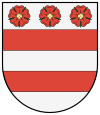 Coat of arms | |
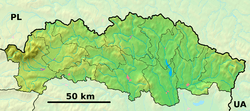 Prešov Location in Slovakia  Prešov Prešov (Slovakia) | |
| Coordinates: 49°00′06″N 21°14′22″E | |
| Country | |
| Region | Prešov |
| District | Prešov |
| First mentioned | 1247 |
| Government | |
| • Mayor | Ing. Andrea Turčanová |
| Area | |
| • Total | 80.40 km2 (31.04 sq mi) |
| Elevation | 250 m (820 ft) |
| Population (2018-12-31[1]) | |
| • Total | 88,680 |
| • Density | 1,100/km2 (2,900/sq mi) |
| Time zone | UTC+1 (CET) |
| • Summer (DST) | UTC+2 (CEST) |
| Postal code | 080 01, 080 02, 080 03, 080 04, 080 05, 080 06 |
| Area code(s) | +421-51 |
| Car plate | PO, PV |
| Website | www.presov.sk |
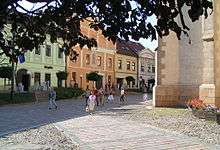
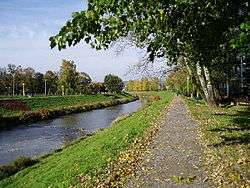
Etymology
The first written mention is from 1247 (Theutonici de Epuryes).[3] Several authors tried to derive the name from Hungarian: eper (strawberry). The theory was questioned in 1940s and newer Slovak works suggests a derivation from Slavic personal name Preš/Prešä and its later phonetic adaptation (introduction of e before the initial consonant group and removal of the suffix, the original form then ceased to exist).[3] Strawberries[lower-alpha 1] depicted on the coat of arms of Prešov are not necessarily determinative, the Latin name Fragopolis (strawberry city) is only a modern translation.[3]
Other alternative names of the city include German: Eperies (between 1938 and 1945 also Preschau), Hungarian Eperjes, Polish Preszów, Romany Peryeshis, Russian Пряшев (Pryashev) and Rusyn and Ukrainian Пряшів (Priashiv).
People from Prešov are traditionally known as koňare which means "horse keepers".[lower-alpha 2]
Characteristics
The old town is a showcase of Baroque, Rococo and Gothic architecture. The historical center is lined with buildings built in these styles. In the suburbs, however, the Soviet influence is clearly evident through the massive concrete panel buildings (paneláky) of the housing estates (sídliska) and the Sekčov district. More Soviet-style architecture is seen in the government buildings near the city center.
Significant industries in the city include mechanical and electrical engineering companies and the clothing industry. Solivary, the only salt mining and processing company in Slovakia, also operates in the city. The city is a seat of a Greek Catholic metropolitan see and of the primate of the autocephalous Orthodox Church of the Czech Lands and Slovakia.
Many concerts, operas, operettas and stage plays are performed at the new building of the Jonáš Záborský Theatre (Divadlo Jonáša Záborského), as well as at the older theatre premises.
The city and the region were contenders for European Capital of Culture 2013.[4] The nearby city of Košice was chosen.
History
Habitation in the area around Prešov dates as far back as the Paleolithic period. The oldest discovered tools and mammoth bones are 28,000 years old. Continuous settlement dates back to the 8th century.
After the Mongol invasion in 1241, King Béla IV of Hungary invited German colonists to fill the gaps in population. Prešov became a German-speaking settlement, related to the Zipser German and Carpathian German areas,[2] and was elevated to the rank of a royal free town in 1347 by Louis the Great.[5]
In 1412, Prešov helped to create the Pentapolitana, the league of five towns, a trading group. The first record of a school dates from 1429. After the collapse of the old Kingdom of Hungary after the Ottoman invasion of 1526, Prešov became a border city and changed hands several times between two usually rivalrous domains, Habsburg Royal Hungary and Hungarian states normally backed by the Ottomans: the Eastern Hungarian Kingdom, the Principality of Transylvania, and the Principality of Upper Hungary.
Still, Prešov went through an economic boom thanks to trade with Poland. In the 16th century it brought in grape vines from the nearby Tokaj wine region, and was home to German-Hungarian, Polish and Greek wine merchants. Some of the first books on Tokaj wine were written in German in Prešov.[2]
In 1572, salt mining began in Solivar (at that time a nearby town, now part of Prešov).

Antun Vrančić, a Croatian[6] prelate, writer, diplomat and Archbishop of Esztergom, died in Prešov in 1573.
Prešov was prominent in the Protestant Reformation. It was at the front line in the 1604–1606 Bocskai Uprising, when Habsburg commander Giorgio Basta retreated to the town after failing to take Košice from the Protestant rebels.
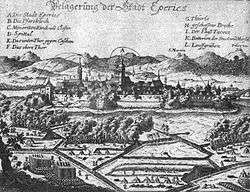
In 1647 the Habsburgs designated it the capital of Sáros county. In late January 1657, Transylvanian Prince George II Rákóczi, a Protestant, invaded Poland with army of some 25,000 which crossed the Carpathians on the road from Prešov to Krosno.
Wolfgang Schustel, a Lutheran reformer during the Reformation, who adopted an uncompromising position on public piety worked in Prešov and other towns. In 1667, the important Evangelical Lutheran College of Eperjes was established by Lutherans in the town.
Imre Thököly, the Protestant Hungarian rebel and Ottoman ally studied at the Protestant college here. In 1685 he was defeated here by the Habsburg at the Battle of Eperjes. In 1687 twenty-four prominent citizens and noblemen were executed, under a tribunal instituted by the Austrian general Antonio Caraffa,[5] for supporting the uprising of Imre Thököly:
"The city particularly suffered during the religious conflicts of the seventeenth century, when it had a reputation for Protestant anti-Habsburg sentiment. In 1687, General Carafa, an emissary of the Austrian emperor, imprisoned a group of local noblemen suspected of insurrection in a former wine warehouse off the square now known as Caraffa's Prison. He subsequently, and notoriously, had 24 of them tortured, executed and their heads placed on spikes around the town, after what we would now call a show trial."[7]
At the beginning of the 18th century, the population was decimated by the Bubonic plague and fires and was reduced to a mere 2,000 inhabitants. By the second half of the century, however, the town had recovered; crafts and trade improved, and new factories were built. In 1752 the salt mine in Solivar was flooded. Since then salt has been extracted from salt brine through boiling.
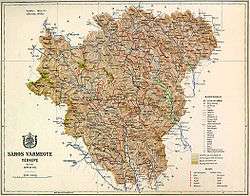
The English author John Paget visited Presov and describes it in his 1839 book Hungary and Transylvania.[8] In 1870 the first railway line was built, connecting the town to Košice. At the end of the 19th century, the town introduced electricity, telephone, telegraph and a sewage systems. In 1887 fire destroyed a large part of the town.
On 16 June 1919, the very brief Slovak Soviet Republic was declared here. In 1920, after the Treaty of Trianon, Eperjes became part of the newly created Czechoslovakia as Prešov. During World War II, the nearby town of Košice again became part of Hungary as a result of the First Vienna Award. As a result, many institutions moved from Košice to Prešov, thus increasing the town's importance. In 1944, a professional Slovak Theatre was established in Prešov. The city is a site in the Holocaust:
"In 1940, on the eve of the Holocaust, Prešov contained five synagogues and more than one in six of the city's population—4,308 people—was Jewish. Three of the synagogues are still standing, but the Jewish community now numbers fewer than 60. Outside the sole functioning synagogue, on Švermova just off the main square, is a memorial to the 6,400 Jews from Prešov and the surrounding region who died in the Holocaust. The broad path leading to the tombstone-shaped monument, surrounded by prison-like bars, is intended to represent the Jewish pre-war population; the narrow path that leads on from it to the synagogue, those who survived."[7]
About two thousand Jews were deported from Prešov to the Dęblin–Irena Ghetto in May 1942. Only a few dozen survived.[9]
On 19 January 1945 Prešov was taken by Soviet troops of the 1st Guards Army. After 1948, during the Communist era in Czechoslovakia, Prešov became an industrial center. Due to the World War II Prešov lost majority of its Jewish population, however population of the city increased rapidly from 28,000 in 1950 to 52,000 in 1970 and 89,000 in 1990.
Geography
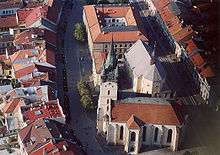
Prešov lies at an altitude of 250 metres (820 ft) above sea level and covers an area of 70.4 square kilometres (27.2 sq mi).[10] It is located in the north-eastern Slovakia, at the northern reaches of the Košice Basin, at the confluence of the Torysa River with its tributary Sekčov. Mountain ranges nearby include Slanské vrchy (south-east), Šarišská vrchovina (south-west), Bachureň (west) and Čergov (north). The neighbouring city of Košice is 34 kilometres (21 mi) to the south. Prešov is about 50 kilometres (31 mi) south of the Polish border, 60 kilometres (37 mi) north of the Hungarian border and is some 410 kilometres (255 mi) northeast of Bratislava (by road).
Climate
Prešov has a warm humid continental climate, bordering an oceanic climate. Prešov has four distinct seasons and is characterized by a significant variation between somewhat warm summers and slightly cold, snowy winters.
| Climate data for Prešov | |||||||||||||
|---|---|---|---|---|---|---|---|---|---|---|---|---|---|
| Month | Jan | Feb | Mar | Apr | May | Jun | Jul | Aug | Sep | Oct | Nov | Dec | Year |
| Average high °C (°F) | −0.6 (30.9) |
1.7 (35.1) |
8.3 (46.9) |
13.9 (57.0) |
19.4 (66.9) |
22.2 (72.0) |
23.9 (75.0) |
23.9 (75.0) |
20.0 (68.0) |
13.9 (57.0) |
5.6 (42.1) |
1.1 (34.0) |
12.8 (55.0) |
| Daily mean °C (°F) | −3.3 (26.1) |
−1.7 (28.9) |
3.9 (39.0) |
8.9 (48.0) |
13.9 (57.0) |
16.7 (62.1) |
18.3 (64.9) |
17.8 (64.0) |
14.4 (57.9) |
9.4 (48.9) |
2.8 (37.0) |
−1.7 (28.9) |
8.3 (46.9) |
| Average low °C (°F) | −6.1 (21.0) |
−5.0 (23.0) |
−0.6 (30.9) |
3.3 (37.9) |
8.3 (46.9) |
11.1 (52.0) |
12.2 (54.0) |
11.7 (53.1) |
8.9 (48.0) |
4.4 (39.9) |
0.0 (32.0) |
−3.9 (25.0) |
3.7 (38.6) |
| Average precipitation mm (inches) | 33 (1.3) |
28 (1.1) |
34 (1.3) |
47 (1.9) |
66 (2.6) |
92 (3.6) |
78 (3.1) |
72 (2.8) |
51 (2.0) |
40 (1.6) |
46 (1.8) |
35 (1.4) |
622 (24.5) |
| Source: [11] | |||||||||||||
Demographics
Historic
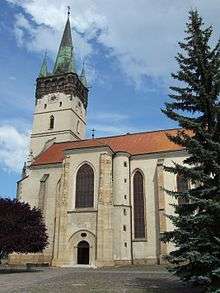
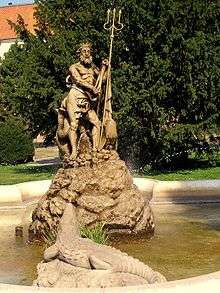
In the past, Prešov was a typical multiethnic town where Slovak language, Hungarian, German and Yiddish were spoken.
| Mother tongue |
census 1880 | census 1890 | census 1900 | census 1910 | ||||
|---|---|---|---|---|---|---|---|---|
| Number | % | Number | % | Number | % | Number | % | |
| Slovak | 5,705 | 56.27% | 5,573 | 53.74% | 6,804 | 47.10% | 6,494 | 39.78% |
| Hungarian | 1,963 | 19.36% | 2,670 | 25,74% | 5,513 | 38.16% | 7,976 | 48.86% |
| German | 1,889 | 18.63% | 1,786 | 17.22% | 1,705 | 11.80% | 1,404 | 8.60% |
| Romanian | 2 | 0.02% | 4 | 0.04% | 27 | 0.19% | 170 | 1.04% |
| Rusyn | 162 | 1.60% | 106 | 1.02% | 121 | 0.84% | 47 | 0.29% |
| Serbo-Croatian | 5 | 0.05% | - | - | - | - | - | - |
| Serbian | - | - | 5 | 0.05% | 5 | 0.03% | 2 | 0.01% |
| Croatian | - | - | 0 | 0.0% | 6 | 0.04% | 4 | 0.02% |
| Slovenian | - | - | 0 | 0,0% | - | - | - | - |
| Other | 132 | 1.30% | 227 | 2,19% | 226 | 1.84% | 226 | 1.38% |
| Foreign (non-Hungarian) | 30 | 0.30% | - | - | - | - | - | - |
| Cannot speak | 251 | 2.48% | - | - | - | - | - | - |
| Total | 10,139 | 10,317 | 14,447 | 16,323 | ||||
Before World War II Prešov was a home for a large Jewish population of 4,300 and housed a major Jewish museum. During 1939 and 1940 the Jewish community absorbed a flow of Jewish refugees from German Nazi-occupied Poland, and in 1941 additional deportees from Bratislava. In 1942 a series of deportations of Prešov's Jews to the German Nazi death camps in Poland began. Plaques in the town hall and a memorial in the surviving synagogue record that 2 6,400 Jews were deported from the town under the Tiso government of the First Slovak Republic. Only 716 Jewish survivors were found in the city and its surrounding when it was liberated by the Soviet Red Army in January 1945.
Modern
According to the 2011 census, Prešov had 91 782 inhabitants, 81.14% declared Slovak nationality, 1.70% Romani, 1.59% Rusyn, 0,7% Ukrainian, 0.48% Czech, 0.14% Hungarian, 13.8% did not declare any nationality.[13]
The religious make-up was 55.8% Roman Catholics, 12.44% people with no religious affiliation, 8.15% Greek Catholics, 4.05% Lutherans, 1.55% Orthodox, 17.16% did not declare any religious affiliation.[14]
Transport
The town lies on the Košice-Žilina railway. Trains depart and arrive from Prešov railway station
Education
Institutions of tertiary education in the city are the University of Prešov with 12,600 students, including 867 doctoral students,[15] and the private International Business College ISM Slovakia in Prešov, with 455 students.[16] In addition, the Faculty of Manufacturing Technologies of the Technical University of Košice is based in the city.
There are 15 public primary schools, six private primary schools and two religious primary schools.[17] Overall, they enroll 9,079 pupils.[17] The city's system of secondary education consists of 10 gymnasia with 3,675 students,[18] 4 specialized high schools with 5,251 students[19] and 11 vocational schools with 5,028 students.[20][21]
Sports
Football
Prešov is home to one professional football team: 1. FC Tatran Prešov which is the oldest football team in Slovakia.
Ice hockey
The city's ice hockey club is HC Prešov Penguins. Home arena of Prešov is ICE Arena and it has capacity of 5500 visitors.
Handball
The city's handball club is HT Tatran Prešov which is Slovakia's most popular and currently most successful club. Handball team of Prešov is taking part not only in Slovak league (where is dominating), but also in international SEHA league with best handball teams from region. Many handball players from this team are also members of Slovak national handball team.
Hiking trails
- European walking route E8
- Prešov - Miháľov - Kurimka - Dukla - Iwonicz-Zdrój – Rymanów-Zdrój - Puławy – Tokarnia (778 m) – Kamień (717 m) – Komańcza - Cisna - Ustrzyki Górne - Tarnica - Wołosate.
See also
- List of people from Prešov
- Šariš Brewery
- Executive Court of Prešov
Twin towns – sister cities
Prešov is twinned with:[22]











Notes
- The original and the current coat of arms does not contain any strawberries, but three roses. Also the privilege granted by Ladislaus the Posthumous (1453) says clearly about "three roses". Strawberries were added only by Ferdinand I (1548) and were held by an eagle in the left hand side of the coat under the three roses. Javor 2004.
- Public horse breeding stud was built in 1859 in Prešov on Sabinovská ulica, it was a stop for horses on their way to Budapest and gained popularity quickly, so citizens of Prešov were called horse keepers after this famous spot of Austria-Hungary. Horses are also depicted on the jerseys of Prešov's football team, 1. FC Tatran Prešov, which is the very first official football team in Slovakia, founded on 25 May 1898 as Eperjesi Torna és Vívó Egyesület (Hungarian).
References
- "Population and migration". Statistical Office of the Slovak Republic. Retrieved 16 April 2019.
- Lambert-Gócs, Miles (November 2010). Tokaji Wine: Fame, Fate, Tradition. ISBN 9781934259498.
- Štefánik, Martin; Lukačka, Ján, eds. (2010). Lexikón stredovekých miest na Slovensku [Lexicon of Medieval Towns in Slovakia] (PDF) (in Slovak and English). Bratislava: Historický ústav SAV. pp. 331, 352. ISBN 978-80-89396-11-5. Archived from the original (PDF) on 2 March 2014. Retrieved 29 December 2016.
- See Presov 2013 website Archived 11 March 2008 at the Wayback Machine
-

- Setton, Kenneth Meyer (1984). The Papacy and the Levant, 1204–1571: The Sixteenth Century. IV. Philadelphia: The American Philosophical Society. p. 921. ISBN 0-87169-162-0.
- "Travel".
- Paget, John (1850). Hungary and Transylvania (new ed.). Lea Blanchard. Retrieved 24 January 2013.
- Büchler, Yehoshua (1991). "The deportation of Slovakian Jews to the Lublin District of Poland in 1942". Holocaust and Genocide Studies. 6 (2): 159, 166. doi:10.1093/hgs/6.2.151. ISSN 8756-6583.CS1 maint: ref=harv (link)
- "Municipal Statistics". Statistical Office of the Slovak republic. Archived from the original on 17 December 2007.
- weatherbase.com—http://www.weatherbase.com/weather/weather.php3?s=592929]. Retrieved 24 December 2017.
- Majo, Juraj (2012). Historicko-demografický lexikón obcí Slovenska. Bratislava: Štatistický úrad SR. ISBN 978-80-8121-222-2.
- "Obyvateľstvo podľa pohlavia a národnosti" (PDF). Sčítanie obyvateľov, domov a bytov 2011 (in Slovak). Štatistický úrad SR. Retrieved 29 December 2016.
- "Obyvateľstvo podľa pohlavia a náboženského vyznania" (PDF). Sčítanie obyvateľov, domov a bytov 2011 (in Slovak). Štatistický úrad SR. Retrieved 29 December 2016.
- "Technická univerzita Košice" (PDF) (in Slovak). Ústav informácií a prognóz školstva. Archived from the original (PDF) on 27 February 2008. Retrieved 4 March 2008.
- "Vysoká škola medzinárodného podnikania ISM Slovakia" (PDF) (in Slovak). Ústav informácií a prognóz školstva. Archived from the original (PDF) on 8 May 2007. Retrieved 4 March 2008.
- "Prehľad základných škôl v školskom roku 2006/2007" (PDF) (in Slovak). Ústav informácií a prognóz školstva. 2006. Archived from the original (PDF) on 9 April 2008. Retrieved 4 March 2008.
- "Prehľad gymnázií v školskom roku 2006/2007" (PDF) (in Slovak). Ústav informácií a prognóz školstva. Archived from the original (PDF) on 9 April 2008. Retrieved 4 March 2008.
- "Prehľad stredných odborných škôl v školskom roku 2006/2007" (PDF) (in Slovak). Ústav informácií a prognóz školstva. Archived from the original (PDF) on 9 April 2008. Retrieved 4 March 2008.
- "Prehľad združených stredných škôl v školskom roku 2006/2007" (PDF) (in Slovak). Ústav informácií a prognóz školstva. Archived from the original (PDF) on 9 April 2008. Retrieved 4 March 2008.
- "Prehľad stredných odborných učilíšť a učilíšť v školskom roku 2006/2007" (PDF) (in Slovak). Ústav informácií a prognóz školstva. Archived from the original (PDF) on 27 February 2008. Retrieved 4 March 2008.
- "Partnerské mestá" (in Slovak). Prešov. Retrieved 2 September 2019.
Bibliography
- Horváth, Tibor (1999). Szlovákia (in Hungarian) (1st ed.). Budapest: Cartographia. ISBN 963-353-180-2.
- Javor, Martin (2010). Heraldika na východnom Slovensku [Heraldry in Eastern Slovakia] (PDF) (in Slovak). Prešov: Metodicko-pedagogické centrum v Prešove. p. 38. Archived from the original (PDF) on 20 September 2008. Retrieved 29 December 2016.
- Official History of Prešov
- Prešov town hall (July 2002), Prešov - city profile. Retrieved in June 2004 from http://www.pis.sk/jpis/obsah/html/presov_profile.htm.
External links
- Webpage of the town
- DPMP - Public Transport Official Site
- Prešov information from Slovakia.org
- Video about Prešov
Gallery
- Christmas congratulation from Prešov
- Cathedral of St. John the Baptist
- Cathedral of St.Nicholas
- Historical building of the College
- Renaissance House Sigismund Rákóczi
 Late Gothic Caraffa prison
Late Gothic Caraffa prison Synagogue
Synagogue Blacksmith bastion
Blacksmith bastion Town hall
Town hall Orthodox Cathedral of St. Prince A. Nevsky
Orthodox Cathedral of St. Prince A. Nevsky- Calvary
- Immaculata
- Statue of St. Rochus
- Main Street
- Bishop's Palace Greek Catholic Church
- Slovak street
- Remnants of city walls
- Franciscan Church of St. Joseph